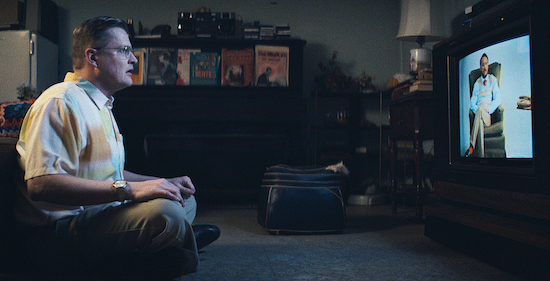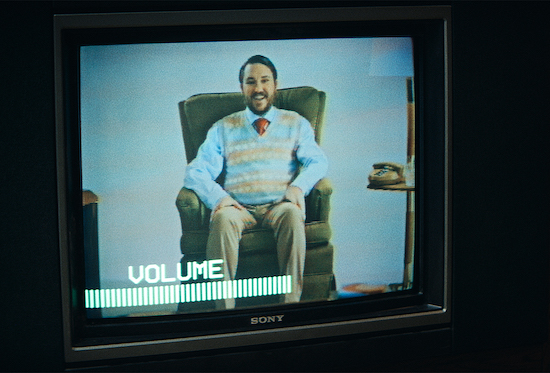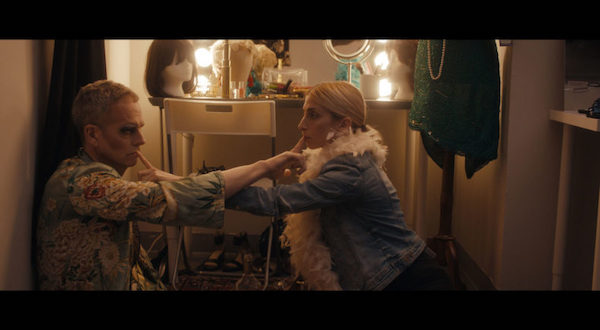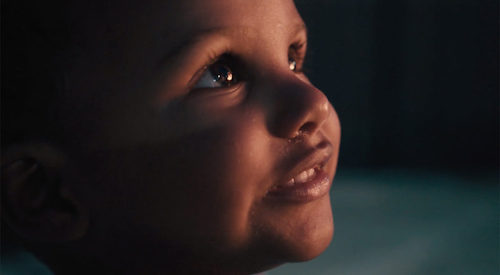- 4 years ago
-

Dark Star Pictures Orçun Behram’s feature debut The Antenna will probably be most meaningful for those living in Turkey, the Istanbul-based filmmaker’s birthplace. His stylish horror movie portrays a dystopian world in which a broadcasting system installed in apartment complexes turns out to be a monstrous presence, a clear (sometimes too clear) metaphor for life under the current regime. Beautifully shot in sickly, muted tones, the action takes place in a bleak-looking neighborhood of drab high-rises and is experienced mainly through the eyes of the soulful put-upon building attendant Mehmed (Ihsan Önal).
We first learn about the new government initiative through cheerful news bulletins, followed by the arrival of a technician who sets up a satellite dish on the roof of Mehmet’s building. When the guy abruptly meets a bad end, Mehmet’s supervisor Cihan (Levent Ünsal), a classic mid-level bureaucrat, is suspiciously nonchalant about the whole business.
Things around the apartment complex soon become very weird and threatening, as an oozing black liquid begins seeping into every apartment and scene. We see how three different tenants (a single woman, a couple with a young son, and the family of Mehmet’s friend Yasemin) fare as something inexplicable takes over.

Dark Star Pictures The Antenna starts out quietly, but its soundtrack gradually becomes ominous and intrusive, featuring the magnification of seemingly benign sounds. Visually, there are a variety of familiar references–overhead shots, close-ups, strange and grotesque angles, many reminiscent of the surreal work of David Cronenberg or Terry Gilliam (Brazil) The Big Brother theme is also very evocative and there is some obvious symbolism (bird in cage) which makes the film less than gripping, despite its grimly effective vibe.
The film is a slow creep, eventually surging beyond dystopia into full-blown hell. Though the many elements that obviously inspired Behram are a bit of a drawback, there’s enough here to suggest a promising future for Behram.

Sweet 180 The subject of Lillian LaSalle’s documentary My Name is Pedro is one of the most unsung of leaders, a public school administrator. Pedro Santana is an especially worthy example of that group: a former special ed kid from an impoverished family who wound up devoting his life to the education of children from similar backgrounds. He’s also a warm personality and charismatic visual figure whose long hair often drew comparisons to Michael Jackson (not a bad thing at one time).
LaSalle documented Santana’s life over the course of seven years for her debut feature (she previously served as producer on several other films), so it’s understandable that the result is at times a bit rambling. A lot took place, especially during Santana’s time as assistant superintendent of the East Ramapo Central School District in Rockland County, N.Y., where he was brought in to help smooth over tensions between the parents of public school children and members of the local school board representing the area’s Orthodox Jewish community.
Santana’s ascent to that role is remarkable—from struggling Bronx student to Peace Corps volunteer (unusual for someone from his background) to public school teacher (after getting himself into Columbia’s Teachers College) to assistant principal, then principal—Santana owes his success to one particularly supportive grade-school teacher. An inspiration to both parents and students, many of whom are interviewed for the film, he himself changed the lives of several students by connecting with them individually. After improving the grades of several Bronx schools, Santana was courted by the East Ramapo school district, a similarly challenged area.

Sweet 180 Despite difficult obstacles—both public (including a struggle for power within the school board) and tragically personal—Santana perseveres.
Though completed in 2017, the documentary feels particularly inspiring during these turbulent times. It’s a reminder of just how much of a difference a good educator can make in the life of a young person or a school. This might sound all very obvious, but when we watch someone like Santana in action, we both moved by his compassion and commitment, and saddened by the fact that a he’s a rarity.
The Antenna and My Name is Pedro open in virtual cinemas on Friday, October 2.
—Marina Zogbi
Latest News
- 4 years ago
-
There will undoubtedly be many movies coming out in the near future about life during the pandemic, but I’m not sure any of them will top the beautiful, resonant short Sincerely, Erik, by filmmaker Naz Riahi. This charming work about a bookseller navigating isolation in NYC during Covid-19 (played by actual bookseller Erik DuRon) was shot on location in June. Check it out: https://vimeo.com/434705621
Now that we’ve hopefully weathered the worst of it (at least in New York) and we’re feeling somewhat less traumatized by the pandemic — if not by other current events — it might feel OK to watch dark films again?

Sibyl, courtesy of Music Box Films Two new movies that fit that description, albeit in very different ways, are Justine Triet’s mostly French-language psychodrama Sibyl and Jon Stevenson’s horror-thriller Rent-a-Pal, out on Friday. Both films are darkly comic and they both build to pretty extreme endings, but the similarities end there.
Sibyl is Triet’s third feature, all of which center on complicated women trying to keep it together amid tricky relationships and difficult situations. As in 2016’s In Bed with Victoria, the protagonist is played by the luminous Virginie Efira as the title character. Sibyl is a psychotherapist who is leaving the profession to write a novel — until she is pulled back in by a young woman desperate for her help.
That is Margot (a beguiling Adèle Exarchopoulos), an actress who is anxious about shooting her first major film, which happens to co-star her married lover Igor (Gaspard Ulliel).

Sibyl, courtesy of Music Box Films There’s a lot going on around this core plot line, as well as in Sibyl’s life and head, including her needy sister Edith (Laure Calamy, so memorable in the series Call My Agent) and the lurking legacy of their deceased mother; Sibyl’s husband and their two young daughters; and her ex-boyfriend Gabriel (Niels Schneider), about whom she can’t stop thinking and fantasizing. In conveying all this, Sibyl is full of short, impressionistic scenes and flashbacks, which can sometimes feel disjointed.
When the increasingly dependent Margot begs Sibyl to come visit her film set in Italy, things really get complicated. This film within a film is directed by Igor’s practical wife Mika (the funniest character in the film, played by the fabulous Sandra Hüller), who is hell-bent on keeping the production going, as her actors (including her husband) argue and misbehave. Somehow, Sibyl — whose own psychic cracks are beginning to show — becomes the person everyone confides in and relies on.
Sibyl is funny and flamboyant, but it’s also about loss, sadness and self-worth. Triet stuffs a lot into her movie, and while the result is messy, it’s also fascinating and highly watchable (thanks in large part to its excellent cast).

Rent-A-Pal, courtesy of IFC Films The first feature from writer/director Jon Stevenson, Rent-A-Pal is based on a video he found of an old VHS tape called “Rent-A-Friend,” featuring a strange, friendly guy offering advice and companionship to lonely people. That’s a good premise for either a comedy or horror movie; the spare, disquieting Rent-A-Pal falls mainly into the latter category.
The film takes place in 1990, but the garish visuals, music and technology scream ’80s. Forty-year-old David (Brian Landis Folkins) is a classic solitary, sensitive type — serving as caretaker for his dementia-riddled mother (Kathleen Brady), while living in her basement. He spends a lot of time and money on Video Rendezvous, a video-profile dating service, but is not having any luck getting matched.
One day, he finds an intriguing videotape starring the super-amiable Andy (Wil Wheaton), a guy who seems to understand poor souls like David, and who offers advice and support. He asks questions and comments on David’s answers, with the ensuing “dialogue” sometimes eerily synching up. As David’s life become more depressing, he is drawn to repeated viewings of “Rent-A-Pal.”

Rent-A-Pal, courtesy of IFC Films Meanwhile, Video Rendezvous has come up with a match for David and it’s a good one. Lisa (Amy Rutledge) is a fellow sensitive soul and caretaker who seems to get him.
You don’t have to be a horror movie buff to know that mysterious, intriguing videotapes have bad consequences. Rent-A-Pal Andy doesn’t go away despite David’s new relationship, as Wil Wheaton’s beaming smile and bonhomie morphs into something else (this must have been a fun role for him). The fairly slow-paced film becomes increasingly manic, going full-out horror by the end. Creepy. claustrophobic and comic, Rent-A-Pal isn’t completely believable, but it’s suspenseful and fun, not least because of the ‘80s references.
Sibyl opens at Film at Lincoln Center on Friday, Sept. 11; Rent-A-Pal opens the same day On Demand and in select theaters.
— Marina Zogbi
- 4 years ago
-

Event performance celebrating the end of the summer program (2019). Now in its third year, Art for Progress’ summer program gives students the opportunity to learn about life as a professional artist, while also learning new advanced skills to help them achieve their goals.
Funded by the Pierre and Tana Matisse Foundation with additional support from the Sansom Foundation, the program is taught by professional teaching artists with a long history of working with Art for Progress (AFP) in NYC’s Public Schools and other important projects. Thanks to the generous support of our sponsors, the program will be funded through 2021, which gives AFP the opportunity to expand and grow the program even more.
Over the years, the program has invited Grammy nominated musicians, prominent visual artists and high-level fashion designers as its guest speakers. It has been a valuable and exciting part of the program for students and highly rewarding for the artists. There’s no cost for students to attend.
Though the program for this summer will be hosted online, it will be one of the best yet, due in large part to Art for Progress’ newly developed online learning platform: https://learn.artforprogress.org, which was created to optimize the experience for both our teachers and students. The new website includes many valuable features which will enhance learning and promote better communication. This summer’s program is planned over four weekends beginning July 25th and ending August 16th.
The program kicks off with “Skills and Insights for Today’s Musician” with special guest speaker, multi-instrumentalist, composer Ze’ Luis Oliveira. The following week the focus is shifted toward visual art with “Visual Art and Today’s Narrative,” and our special guest artist, illustrator Afua Richardson. The third weekend, “Advanced Skills in Music Production” will focus on helping young creators and producers hone their skills in the studio. Our guest Emilio China AKA Zef Noise will share his insights and experience as a musician, composer and improvisor. The final weekend is “Student’s Choice” where students have the opportunity to suggest the program for the last weekend. It’s open ended and could consist of any genre including performance and fashion design. Our special guest artist is inter-disciplinary artist Belaxis Buil [who’s based in Miami, Florida.
Some of the goals for the program include:
- To gain specific skills to help students progress and develop toward producing and marketing professional level work
- To gain insights into the real experiences of artists not often available in traditional learning environments
- To learn about the many paths an artist can take and to define their own path
This year the program will include the opportunity for students to earn awards for both attendance and participation. Awards will include music gear, private lessons and gift certificates for supplies. The details will soon be announced.
Applications are now open. Please visit https://learn.artforprogress.org and apply today.
In these challenging times, everyone at Art for Progress is proud and excited to have this opportunity to provide this enriching program.
To learn more about Art for Progress, visit www.artforprogress.org.
- 4 years ago
-

Laverne Cox, courtesy of Netflix There’s a scene in Neil Jordan’s 1992 film The Crying Game in which Stephen Rea’s character vomits copiously after discovering that his love interest is not exactly the woman he thought she was. You might not recall that exact moment, but transgender people sure do. There’s a kind of homage to that scene in Ace Ventura: Pet Detective in which Jim Carrey goes way beyond vomit in response to a similar discovery. The latter is so over the top it could almost be a satire of stereotypical film reactions to transgender reveals, but it’s not quite.
Filmmaker Sam Feder has assembled those scenes and many others for the new Netflix documentary Disclosure, which charts the historical representation of transgender and non-binary characters in film and TV. Executive-produced by actress Laverne Cox (who is also interviewed in the film), Disclosure is entertaining, hard-hitting and often cringe-inducing. These often problematic screen depictions shaped not only general views of trans people, but how trans people feel about themselves.
There’s commentary from various entertainment figures including Chas Bono, Candis Cayne, Jen Richards, Yance Ford, Brian Michael Smith and Lilly Wachowski, who describe their own reactions to scenes such as the above-mentioned. Like any marginalized group, trans people always looked for themselves on screen, especially while growing up. According to several Disclosure interviewees, they embraced the few relatable characters presented, even if they or their storylines were questionable (Cayne’s character on “Nip/Tuck,” for example).
In researching the film, Feder took 100 oral histories from trans individuals who work in film and TV, and collected more than 1,000 clips from over 100 years of characters who traverse gender expectations. Though many aren’t technically transgender, especially in early films, these depictions added to many trans people’s overall self-identity.

Sam Feder
Photo: Alex SchmiderInterestingly, notes historian Susan Stryker, trans and cinema grew up together, with gender-fluid characters featured in films such as D.W. Griffith’s Judith of Bethulea (1914). Griffith, also responsible for the racist Birth of a Nation, featured characters who were both cross-dressing and in blackface, making for a double-whammy of insult. Ditto A Florida Enchantment (1914), considered the first film to feature cross-dressing/gender-nonconformity. As discussed in Disclosure, a black man in a dress was seen as especially emasculating, feminine clothes neutralizing the inherent “threat” he posed.
Along with Cox, several others interviewed in Disclosure are trans people of color, who make up a particular segment of those represented in media and in trans American life in general. (Many trans people who are victims of violence, on screen and in real life, are women of color.)
Disclosure features many familiar TV and movie clips, including characters such as Flip Wilson’s iconic Geraldine, played for big laughs. Trans and cross-dressing characters were often the butt of jokes, says Cox. In general we have been trained to laugh at trans people.
When not comic, trans characters have often been represented as dangerous and psychopathic, as in Dressed to Kill and Silence of the Lambs. Several of those interviewed in Disclosure admit they enjoyed the films at the time and only later realized how they internalized the revulsion elicited by these characters. Also disturbing for many is the fact that even progressive TV shows like the ground-breaking “The L Word” included offensive depictions of trans characters.
Unlike trans women, trans men are largely missing in media, note several Disclosure participants. For many, the appearance of Reno on Jerry Springer’s 1998 “My Boyfriend is a Girl!” episode was a defining moment: their first time seeing a black transgender man. On talk shows in general, there has been a salacious focus on body parts and surgery, shown via interviews of Carmen Carrera and Cox by Oprah and Katie Couric, both of whom became more sensitive in later interactions.
An especially moving Disclosure participant is veteran actress Sandra Caldwell, who did not come out as trans until very late in her career, having worked for years in fear of being found out.
There are so many interesting details, issues and points of view, along with myriad clips, packed into 105 minutes, that Disclosure can feel overwhelming in scope. Yet it’s tightly edited, so that it all pulls together coherently.
A welcome and timely addition to Pride Month releases, Disclosure is available on Netflix starting Friday, June 19.
—Marina Zogbi
- 4 years ago
-

Milkwater Like many events these days, the 23rd edition of the Brooklyn Film Festival is going virtual. New York City’s longest-running international competition film fest, which runs this year from Friday, May 29, through Sunday, June 7, is offering a full lineup of over 140 films for free. (Viewers need only register.)
Planned many months ago, the theme of this year’s event is “Turning Point,” which takes on a whole new significance given the implications of the current pandemic. In addition to 15 narrative features and 10 documentary features, there are narrative and documentary shorts, experimental films and animation. The festival’s long-running rules: Participating films cannot be older than two years, films are selected from submissions only, all the selected films participate in the competition, and the smallest film can win the top festival award: The Grand Chameleon. In each of the six film categories, a panel of judges will select the Best Film, while the festival will select the Spirit Award, and the audience the Audience Award winners. There are also awards given for Best Actor, Best Actress, Best Composer, Best Style, Best Editor, Best Cinematographer, Best Screenwriting, Best Producer, Best New Director, and Best Brooklyn Project. The festival’s full slate of films can be found here.
A few highlights:
The Black Emperor of Broadway, directed by Arthur Egeli and written by Ian Bowater, is part of their Provincetown Trilogy collaboration, three narrative films set in the Bohemian community of Provincetown, Cape Cod. The film tells the true story of Charles Gilpin, the immensely talented African-American actor who starred in Eugene O’Neill’s The Emperor Jones in the 1920s. Though the film is a bit stagy and is marred by an overly dramatic soundtrack, it’s buoyed by its excellent actors, especially Shaun Parkes as Gilpin. It’s also a fascinating narrative of the time, including the thorny relationship between the principled Gilpin, who chafed at the play’s racist language, and O’Neill (John Carter Hensley), who–like many playwrights–felt that his words were sacrosanct.

Black Emperor of Broadway Higher Love, directed by Hasan Oswald, is a gritty documentary about Daryl Gant, a Camden, N.J., father of eight who tries repeatedly to help Nani, his crack-addicted girlfriend and the mother of his son. A third major character is Iman, a dealer-turned-addict who attempts to get clean with the support of his multi-generational family. The film features several other locals, many of whom are either part of Camden’s addict community or their relatives. Oswald managed to obtain incredibly intimate access to his subjects, especially Daryl, so that we’re privy to the latter’s frustrations and failings (he occasionally drinks too much), as well as his unflagging determination to help Nani, and his love and concern for his children. Nani and her fellow addicts are shown in the throes of their addiction, helpless to help themselves. Sad and sobering.

Higher Love Milkwater, a comedic drama written and directed by Morgan Ingari, is a likable, assured first feature staring Molly Bernard as a single young Brooklynite who decides to become a surrogate for an older gay man. Milo is a funny, outspoken sort who feels left out when her best friend (Ava Eisenson) has a baby with a wife who seems immune to Milo’s humor. After befriending part-time drag performer Roger (Patrick Breen) in a bar, Milo impulsively offers to have the baby he’s wanted for years. However, the duo have different ideas about their relationship, worsened by her boundary issues and general excessive drinking. (Alcohol plays a prominent role in this movie.) Bernard is perfect as the expressive, exasperating Milo and Breen is solid as the more centered Roger. What could have been a predictable premise turns out to be an engaging film, complete with supporting characters (a trio of “High Fidelity”-like guitar store clerks) and situations (drag night) that call for more screen time. The film feels like a long pilot for a Netflix series, which is not a bad thing.
—Marina Zogbi
